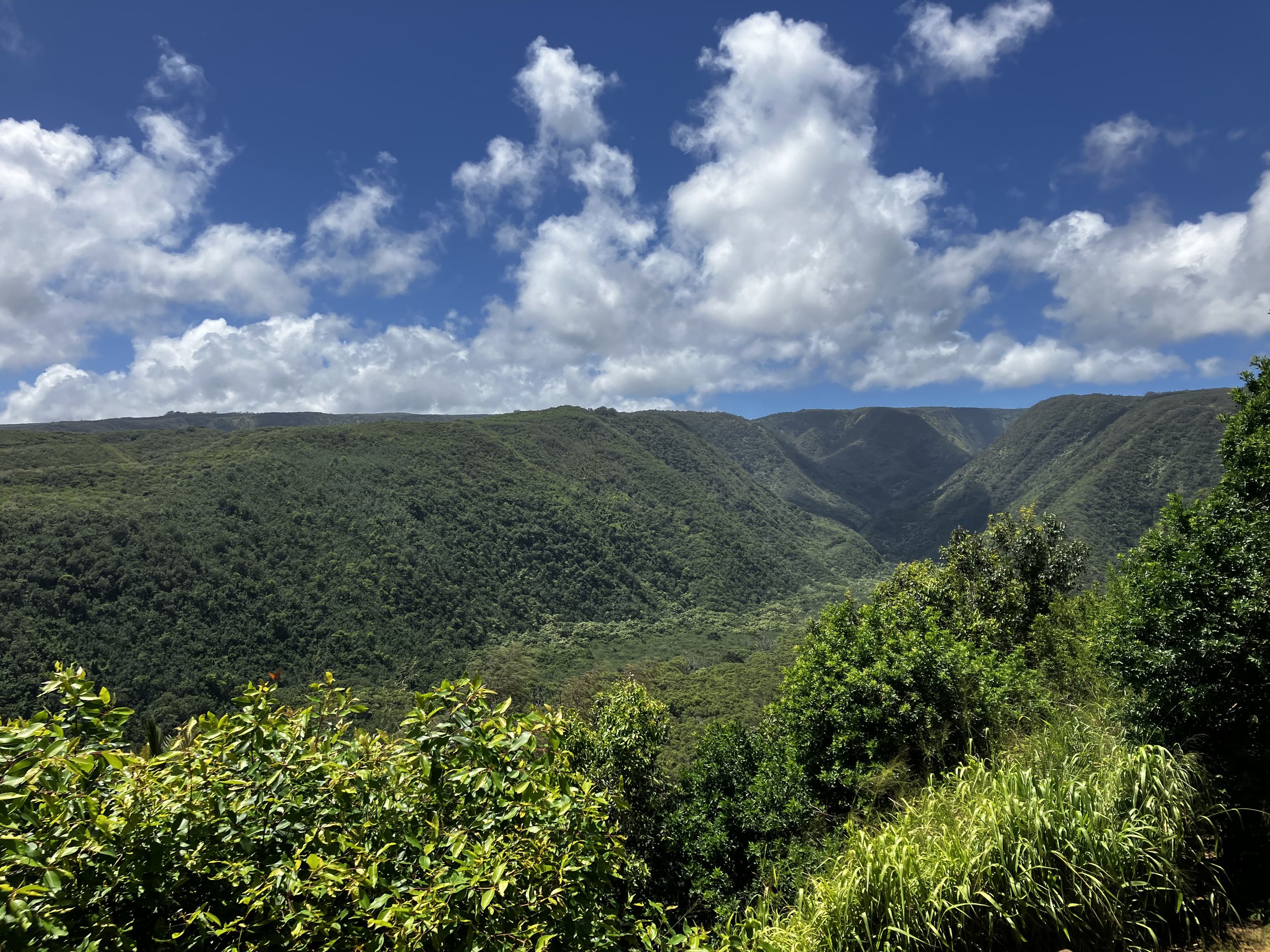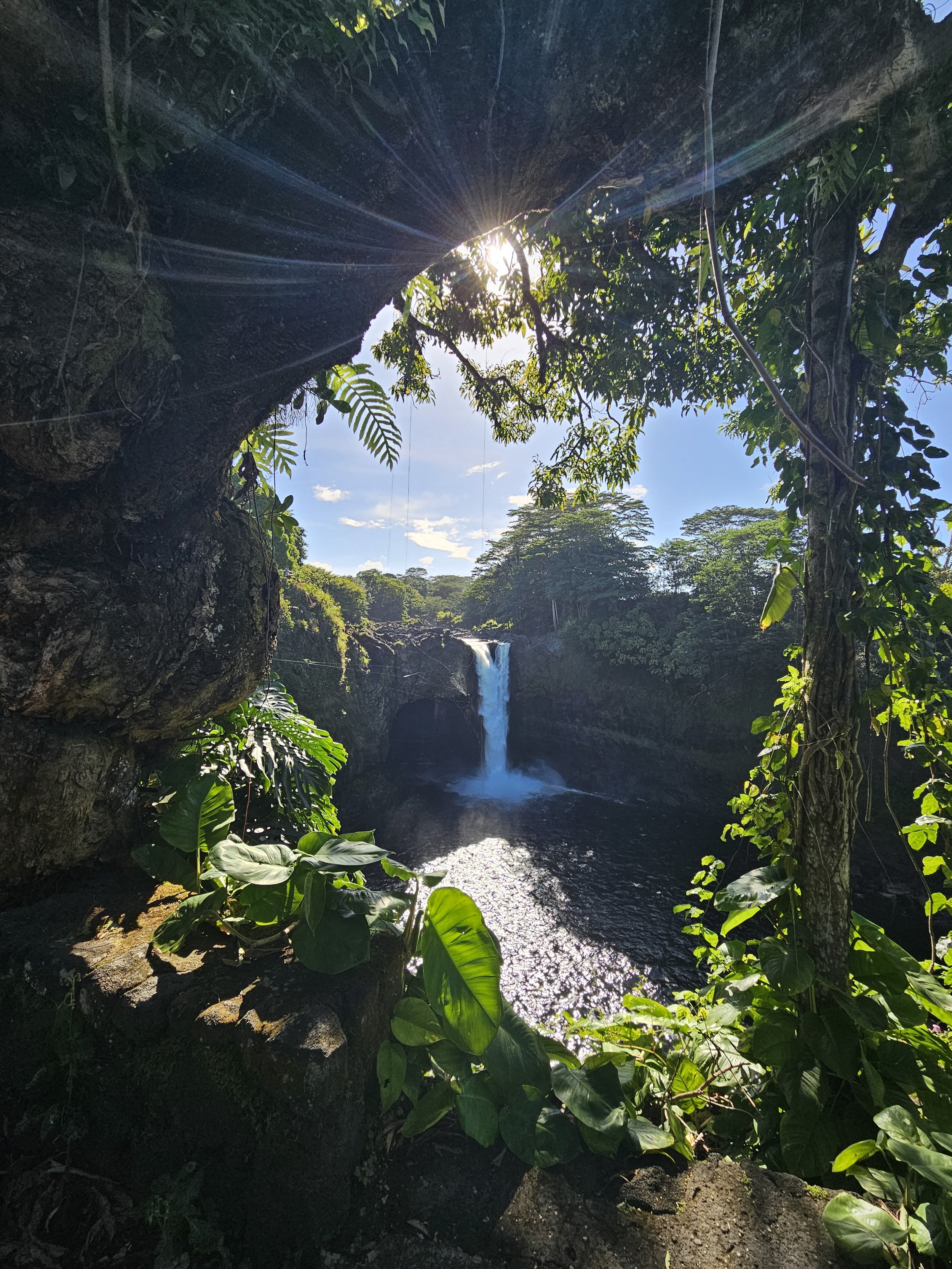Big Island, Hawai'i (Day Three): Polulu Valley, Rainbow Falls, & Kaumana Caves
If you missed days one and two of our trip to the Big Island, go read that post first!
POLOLŪ Valley Hike (~1-1.25 miles round trip)
The Kohala Volcano is the oldest of the volcanoes that make up the Big Island, and when part of this volcano slid into the ocean hundreds of thousands of years ago, it formed the sea cliffs along the Kohala Coast. Erosion has formed seven valleys along this coastline, including Pololū Valley, the most northern valley, then Honokāne Nui, Honokāne Iki, Honokeʻa, Honopue, Waimanu Valley, and Waipi’o Valley. Waipi’o Valley is the most famous, perhaps because of its daring grade or the breathtaking views through the cliffs and back into the valley. We faced Waipi’o last time we visited the Big Island (read about that hike here), but it has actually since been closed to non-locals. Since we loved Waipi’o so much, we decided to do another of the Kohala Coast hikes and settled on Pololū Valley, which is a short but steep hike down to a black sand beach.
The hike begins at the overlook, where there is a small parking lot for those who aren’t intending to hike. They also have a trail steward here, who warns you about carrying enough water and considering whether you’re physically able to make the steep trek. After having no such guidance at the entrance to Waipi’o, one of the literal steepest roads in the world, this set our expectations high for how difficult this hike would be.
However, once we’d started, we found this hike to be a cakewalk compared to Waipi’o and really no more difficult that most hikes that include any kind of significant elevation gain/loss. You do descend about 420 feet on switchbacks in a little over a half mile, but there are plenty of spots to take a rest and a pretty good amount of shade. I had no problem hiking this trail in Chacos at 20 weeks pregnant, and the only real difficulty I found with it was a few sections of loose dirt that were slightly slippery while going downhill.
Once at the bottom, you cross a small stream and reach the black sand beach (which is really more like a black rock beach). The ocean here is not a safe place to swim, but you can take a moment to sit on a piece of driftwood, watch the waves, and eat a snack. Behind the beach, you can walk a short trail through the woods. Make sure you pay attention to areas that are blocked off as private property or because they are sacred cultural sites. This trail used to lead to a connector trail to another of the valleys; however, this trail is no longer open.
After the hike, we drove down to Hilo, stopping for warm, fresh malasadas at Tex Drive-In on our way. These Portuguese donuts are covered in sugar and stuffed with different flavored fillings. Bavarian cream is my personal favorite!
Rainbow Falls
Despite the long drive, we knew this was going to be our one opportunity to visit Hilo on this particular trip, so we decided to use the second half of the day to enjoy some of the free activities we didn’t get to do on our honeymoon to the Big Island. First up was a stop at Rainbow Falls or Waiānuenue, one of the two famous waterfalls you can see in/near Hilo (Akaka is the other, which we visited last trip).
Rainbow Falls is a short walk from the parking lot, where you can see some tropical plants and a massive system of banyan trees. The waterfall itself cascades 80 ft over a lava cave that, according to legends, is home to the ancient Hawaiian goddess Hina, the goddess of the moon.
Botanical Gardens at the University of Hawaii, Hilo
We then drove to the close-by University of Hawaii campus, where we walked through their small outdoor botanical garden. The garden is a little difficult to find, especially because it’s divided into different sections that are separated across the campus. Still, I love a free botanical garden!
Kaumana Caves State Park
This free park (which is really just a parking lot and a picnic table) gives access to a lava tube create by an 1881 flow from Mauna Loa. The tube itself extends 20 miles, but most of this is actually private property, so you can only explore the first 0.1-0.2 miles. You descend via a metal staircase, where you access the lava tube through a collapsed skylight.
Unlike the more developed/popular Thurston Lava Tube in Volcanoes National Park, there were no lights installed inside and the floor was extremely sharp/uneven lava rock. I was really lucky that I always carry a flashlight in my hiking backpack, which provided more light than our phones to see by. This “cave” was also off-the-beaten-path enough that we had a few minutes to ourselves towards the back of the publicly accessible area. We took that opportunity to turn all our lights off, and the sensory deprivation in the pitch black was wild.
Thanks for reading!
Up Next: Arrival in Maui & Snorkeling with Sea Turtles



















